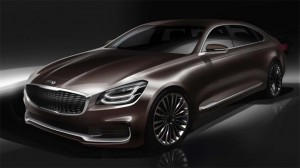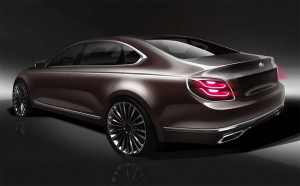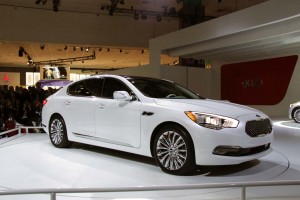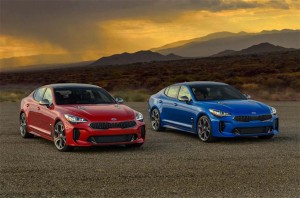Reports of the demise of the big Kia K900 luxury sedan? Well, you know what Mark Twain would say: they’ve been greatly exaggerated.
With the overwhelming response to the new Stinger, there’s no question that Kia is putting a lot of emphasis on that sexy new GT model. But company insiders have repeatedly emphasized to TheDetroitBureau.com that the K900 isn’t going away. And if you needed proof, check out these two renderings of the second-generation sedan that is expected to make a debut appearance in the coming weeks an roll into showrooms by mid-year.
To further underscore its longevity, consider that the new model was a collaborative development pairing Kia’s global design headquarters in the Seoul suburb of Namyang, along with the automaker’s U.S. design center in Irvine, California.
(Hyundai’s Le Fil Rouge concept pushes the design boundaries at Geneva. Click Here to check it out.)
The original K900 seemed, at least initially, like something of an oxymoron considering Kia’s traditional focus on the economy car market. But, like its Korean sibling, the brand has been broadening its appeal and moving into luxury segments – while retaining its value-based pricing strategy.
Of course, it helped to have a platform that Kia could share with Hyundai which launched a similarly sized sedan as the Equus. It now markets its version through the new Genesis brand as the G90.
(Live from Geneva! Click Here for our coverage of the 2018 Geneva Motor Show.)
Both the original Equus and K900 models took aim at wannabe S-Class and 7-Series buyers on a budget. But, as with the new Genesis G90, Kia’s challenge is to now come up with something more sophisticated and world-class or, as it puts it in a news release, a vehicle with “a modern air of elegance and gravitas.”
The new model, it continues, is based on the brand’s “Gravity of Prestige” design concept. That includes a new “Quadric pattern” grille with 176 jewel-like “cells” that are meant to give the car a sense of released energy.
The new K900, if these renderings prove accurate, will be far less of a Euro-clone, with a dramatic, coupe-like curve to the roofline that tapers into a tall, albeit short, decklid.
There’s a large air scoop running corner to corner beneath the grille, strong bulges in a long hood meant to convey a sense of power, and distinctive sheet metal creases flowing from the sweeping LED headlamps to the taillights.
One has to guess that the hood will cover similar engine options to what’s now in the Genesis G90, including a 5.0-liter naturally aspirated V-8 and a sporty turbocharged 3.3-liter V-6.
We’d also expect all the luxury accoutrements, including heated and massaging seats, a high-line infotainment system and an array of advanced driver assistance systems – which could introduce some of the semi-autonomous technologies parent Hyundai-Kia is working on.
There’s one critical difference between Kia and Hyundai, the latter spinning off its luxury line as an entirely separate brand. Kia has so far resisted any temptation to take the same step and it’s all but certain not to give serious consideration to that strategy unless and until the new Genesis brand proves viable. The big test is about to begin, Genesis recently announcing it wants its dealers to set up independent showrooms and no longer share space inside Hyundai stores. That move is expected to cost billions.
We’ll look to find out more in the not-too-distant future. As the next-gen Kia K900 is due out sometime in the second quarter of this year, odds are it will make its official, public debut at the New York International Auto Show later this month.
(Kia brings new Rio GT and Ceed to Geneva. Click Here to check them out.)




